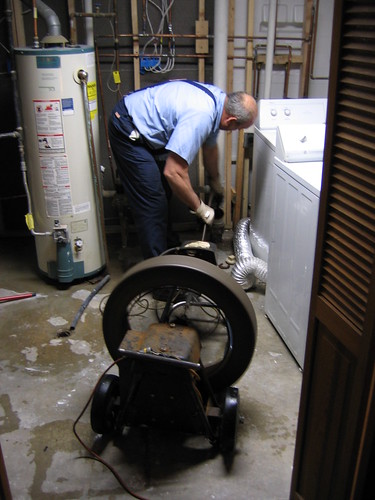
When possible you should get an entry to the drain by removing or opening the associated trap. Very often you will find easy access to a nearby clog. If the obstruction is not immediately seen, the access point can be used to snake both sections of the drain.
On the other hand, some smaller hand-tools will not require you to open a trap or remove a strainer. Tools designed for this purpose will have damage prevention measures, such as no-scratch plastic cables, but should still be used with care around chrome.
Bathroom basin drains are probably the most commonly clogged in the home, aside from the humble toilet. Hair is flushed down the drain, caught by the drain stopper linkage assembly, and congealed with body oil, soap, & toothpaste, until eventually draining from the sink is too slow to stand any longer. Most lavatory blockages will be cleared by disassembling the stopper linkage, and or opening up the U-trap underneath the basin. Bathroom sinks can be scratched or chipped, so be careful! With that in mind, you can sometimes use an auger to clear a bathroom drain after only removing the stopper. There will still be a grate in place, but some cables will be able to fit through. If your auger is oversized or you wish to avoid all chance of damage to the sink, you should remove the trap underneath the basin, providing unobstructed access to the drain for the auger.
There is frequently dangerous standing water when dealing with clogged drains.
Guard yourself against hazardous splash back.
Plumbing can settle, creating gaps at joints. Look for corrosion that may have weakened walls of pipes. Use augers on damaged pipes only with extreme caution, because it could mean a costly repair.
Or even rotate the same direction while the cable is removed—this will keep the corkscrew tip engaged with the obstruction, instead of unscrewing back out.
Always rinse thoroughly with plentiful amounts of hot water after snaking a drain, to rinse all the debris and residue away.
Do not use cable of quarter inch thickness in pipes wider than four inches. It could loop back into a knot and be impossible to remove.
When reeling in the cable you’ll see you are nearing the end.
Showers and floor drains frequently have their traps set in the floor a few feet away. Others will have the required gas trap built directly into and under the drain, in canister form. Drain augers generally cannot be used on canister gas trap drains, which will each have disassembly requirements. But for the more common situation of a straining plate over a drain in the floor, drain snakes are very well suited. As with lavatory basins, smaller tools can frequently be threaded through shower straining plates without their removal. If the plate does need to be removed, exercise care and have a safe spot ready to store any screws or small parts which you do not want dropped in the drain. If you see the nearby trap associated with the drain, you can open the pipes there for best access. Floor gas traps are often capped by one or two large circular end caps with square knobs that can be worked with slip-joint pliers.
You cannot auger through a garbage disposal. Don’t even try, it is dangerous. A clogged kitchen sink with attached disposal must be accessed by opening the trap. If there is no disposal, you may be able to snake directly down the drain, but don’t damage your sink through carelessness.
Bathtubs can be the trickiest clogs to diagnose. There is an overflow drain attached, also a sharp bend in most pipes before reaching the trap, and the trap itself can be inaccessibly hidden in the floor. Tub drains are cleared by first disassembling the stopper leverage. This is usually the location of the clog, and the drain may be cleared just getting room for the auger. If the blockage is not cleaned by removing the stopper, then the auger will be used to first clear this short length of drain from the tub bottom to the nearby T-joint in the pipes.
Once that stretch of bathtub drain is cleared, the snake will be used from the overflow drain, avoiding the sharp bends in the pipes. Smaller tools may be able to thread in behind the protective plate, but you will damage the chrome or aluminum. It is usually easy to remove the plate, one screw, but first cover the drain below with towel or cloth, so anything dropped doesn’t fall in. With the overflow guard removed, unobstructed access to the drain is provided.
 General Pipe Cleaners Spin Thru Drain AugerStamped steel drum. 25-Foot cable capacity
General Pipe Cleaners Spin Thru Drain AugerStamped steel drum. 25-Foot cable capacity
 FlexiSnake Drain Millipede Hair Clog ToolOur toughest hook & loop hair-clog tool. Reusable & works with most bathroom drains without disassembling the stopper
FlexiSnake Drain Millipede Hair Clog ToolOur toughest hook & loop hair-clog tool. Reusable & works with most bathroom drains without disassembling the stopper
 GENERAL Expandable Head Toilet Auger* TOP OF THE LINE * Telescoping action to six feet with full ½ inch diameter cable.
GENERAL Expandable Head Toilet Auger* TOP OF THE LINE * Telescoping action to six feet with full ½ inch diameter cable.
Learn how to prepare plumbing for clearing with a drain auger, safely and without damage to property
UncloggingDrains101.comWhen clogs form in bathroom sinks, showers, bathtubs, kitchen & utility sinks, or shop & laundry drains—then the preferred tool will be a drain auger.
UncloggingDrains101.comWhen you have a toilet plunger, you are well prepared for clearing clogs made up of anything softer than a rubber ducky.
UncloggingDrains101.comEverything about unclogging floor drains, from the toughest job to the quickest maintenance
UncloggingDrains101.comWhich Household Drain Problems Can Be Handled Without Calling A Pro?
UncloggingDrains101.comLearn how to use the common drain snake and be prepared to do-it-yourself when it comes to slow or stopped drains in the home
UncloggingDrains101.com